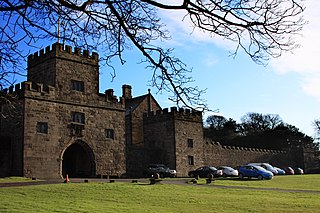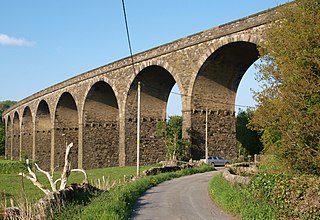
Hoghton Tower is a fortified manor house two-thirds of a mile (1 km) east of the village of Hoghton, Lancashire, England, and stands on a hilltop site on the highest point in the area. It takes its name from the de Hoghton family, its historical owners since at least the 12th century. The present house dates from about 1560–65.

St Michael's Church is an Anglican church in the village of St Michael's on Wyre, Lancashire, England. It is a typical late Medieval church and has been designated by English Heritage as a Grade I listed building. It is an active parish church in the Diocese of Blackburn and the archdeaconry of Lancaster.

Becconsall Old Church is a redundant church in the village of Hesketh Bank, Lancashire, England. It is recorded in the National Heritage List for England as a designated Grade II listed building, and is in the care of the Churches Conservation Trust. It is situated on a lane leading to a boatyard on the River Douglas.

St Wilfrid's Church is an Anglican church in the village of Ribchester in Lancashire, England that is situated close to the site of a Roman fort. It is an active parish church in the Diocese of Blackburn. It is recorded in the National Heritage List for England as a designated Grade I listed building.

St Saviour's Church is an Anglican chapel in Stydd, a hamlet near Ribchester in Lancashire, England. It has been designated a Grade I listed building by English Heritage.

The Church of St Mary and All Saints is an Anglican church in the village of Whalley, Lancashire, England. It is an active parish church in the Diocese of Blackburn. A church probably existed on the site in Anglo-Saxon times and the current building dates from the 13th century. It is recorded in the National Heritage List for England as a designated Grade I listed building.

The Church of St Leonard the Less is an Anglican church in the village of Samlesbury, Lancashire, England, situated close to the banks of the River Ribble. It is an active parish church in the Diocese of Blackburn. It dates predominantly from 1558, with a tower added 1899–1900, and is protected as a Grade I listed building.

Shuttleworth Hall is a 17th-century manor house in the civil parish of Hapton in Lancashire, England. It is protected as a Grade I listed building.

St Cuthbert's is an Anglican church in Lytham, Lancashire, England. It was built 1834–1835, replacing a previous church on the same site. It is an active parish church in the Diocese of Blackburn. Since 1971 it has been designated a Grade II* listed building.

St Leonard's Church is an Anglican church in Walton-le-Dale, Lancashire, England. It is an active parish church in the Diocese of Blackburn and the archdeaconry of Blackburn. In 1950 it was designated as a Grade II* listed building. Parts of the church date from the 16th century and the nave and transepts were rebuilt in the early 20th century.

The Church of St Mary the Virgin is an Anglican church in Goosnargh, a village north of Preston in Lancashire, England. The church dates from the Middle Ages; it was enlarged in the 16th century and restored twice in the 19th century.

St Peter's Church is an Anglican church in the town of Burnley, Lancashire, England. It is an active parish church in the Diocese of Blackburn and the archdeaconry of Blackburn. The oldest part of the church, the lower tower, dates from the 15th century, and there are several later additions and restorations. St Peter's is recorded in the National Heritage List for England as a designated Grade II* listed building. From 1901 to 1977, its rectors simultaneously occupied the suffragan bishopric of Burnley.

St Helen's Church is an Anglican church in the village of Churchtown in Lancashire, England. Historically, it was the parish church of Garstang; today, as Garstang is split into more than one ecclesiastical parish, St Helen's parish is Garstang St Helen (Churchtown). It is in the Diocese of Blackburn. It has been designated a Grade I listed building by English Heritage. St Helen's is known as the "cathedral of The Fylde".

St Thomas' Church is a Church of England church in Garstang, a market town in Lancashire, England. It is an active Church of England parish church in the Diocese of Blackburn and the archdeaconry of Lancaster. The church was built in 1770 as a chapel of ease to St Helen's Church in nearby Kirkland and was later assigned its own parish. It is recorded in the National Heritage List for England as a designated Grade II listed building.

Martholme Viaduct is a 19th-century railway viaduct in the English county of Lancashire. It lies between the town of Great Harwood, in the district of Hyndburn, and the village of Read, in the adjacent Ribble Valley district. As the river that it crosses marks the boundary, the viaduct is thus situated in both those districts.

St Bartholomew's Church is in the town of Great Harwood in Lancashire, England. It is an active Anglican parish church in the Diocese of Blackburn. The church is recorded in the National Heritage List for England as a designated Grade II* listed building.

Heskin Hall is a manor house in Heskin, Lancashire, England. Construction began on the present hall in 1545 making it a Tudor building which has been designated a Grade I listed building by Historic England.

St Wilfrid's Church is an Anglican church in Halton-on-Lune, a village in the English county of Lancashire. It is an active parish church in the Diocese of Blackburn and the archdeaconry of Lancaster. Halton may have been the site of an ancient Anglo-Saxon minster. Of the current structure, the tower dates from the 16th century and the remainder was built 1876–77 by Paley and Austin. The church is recorded in the National Heritage List for England as a designated Grade II listed building.

Ashton Hall is a largely rebuilt 14th-century mansion in the civil parish of Thurnham, Lancashire, England. It is 3 miles (4.8 km) south of the city of Lancaster and is on the east bank of the River Lune. It is recorded in the National Heritage List for England as a Grade I listed building, and is now owned by Lancaster Golf Club.
Great Harwood is a town in Hyndburn, Lancashire, England. It contains 16 buildings that are recorded in the National Heritage List for England as designated listed buildings. Of these, one is listed at Grade I, the highest grade, four are at Grade II*, the middle grade, and the others are at Grade II. The major building in the town is the former manor house, Martholme: this and two associated structures are listed. The other listed buildings include churches and associated structures, farmhouses, large houses, a railway viaduct, a town hall, a bank, a public house, a clock tower, a war memorial, and a telephone kiosk.




















